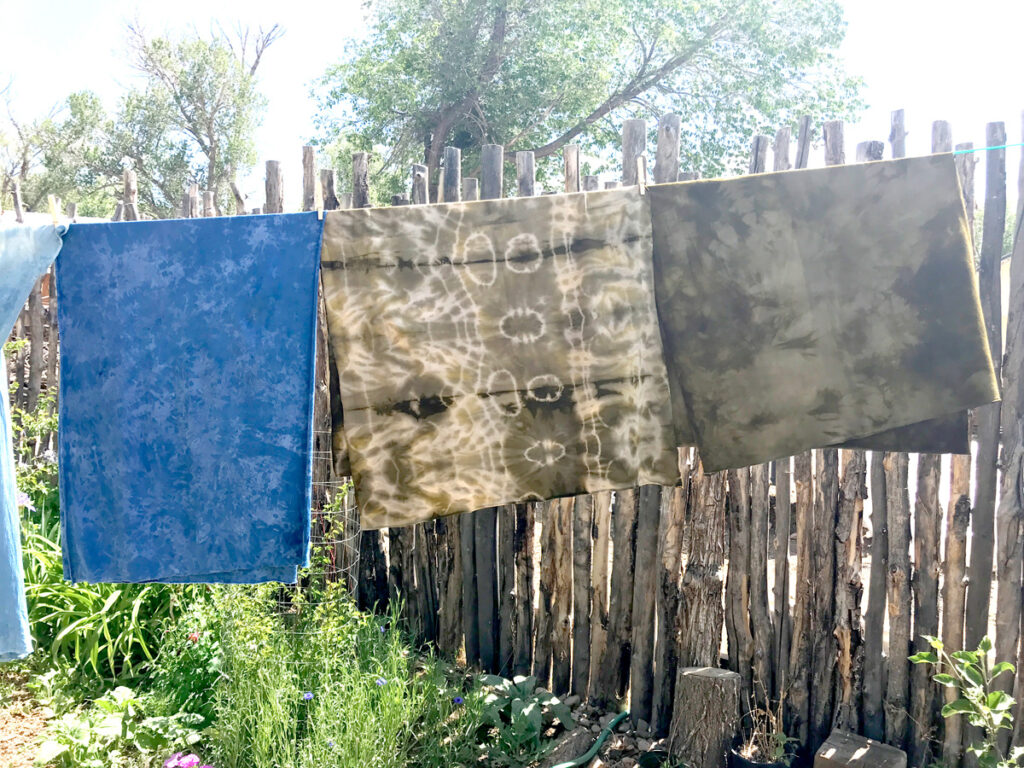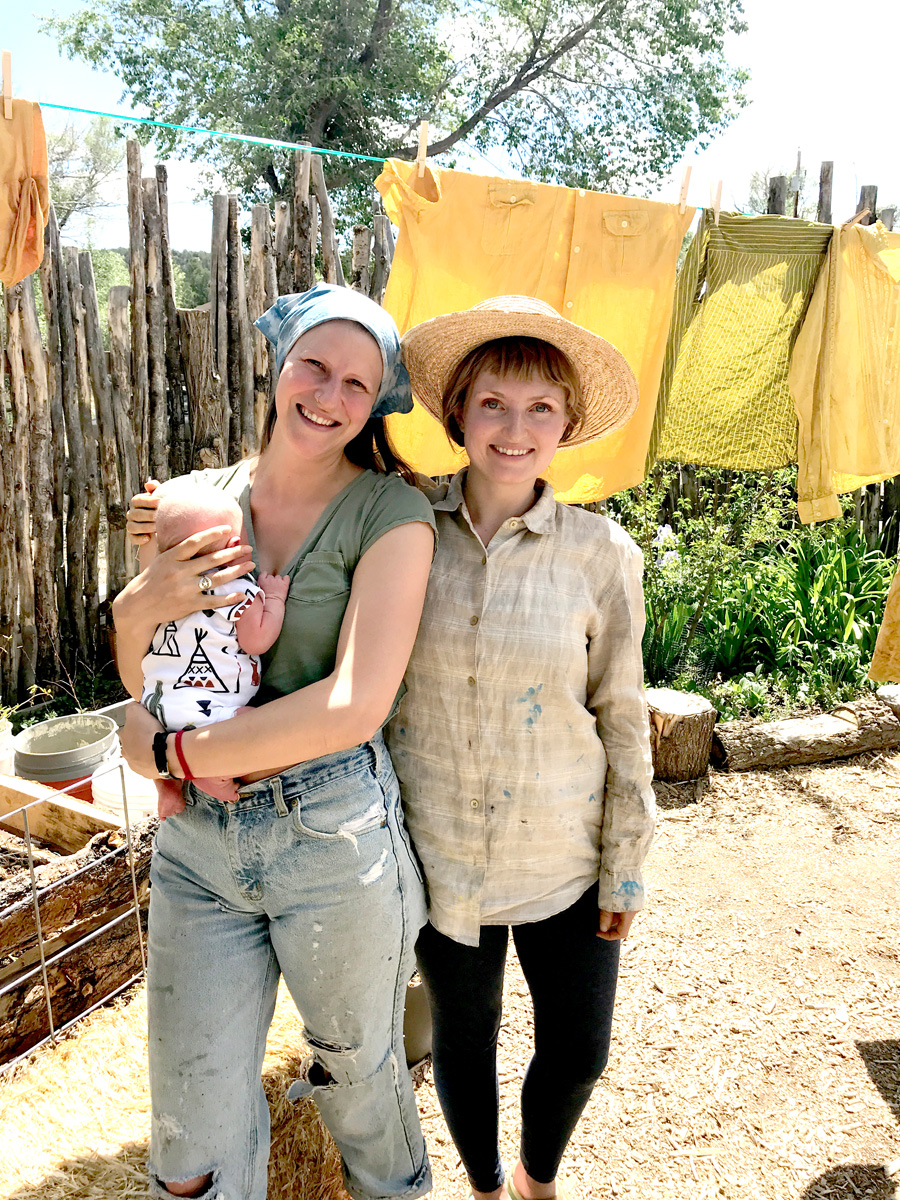In the third installment of our series on sustainable fashion, we explored that segment of the fashion industry known as “upcycling,” taking unwanted garments and making them into something new and of higher value. We saw handbags crafted in Taos with yarn made from old t-shirts, surplus parachutes cut and dyed in the Navajo Nation to make designer skirts, and overstock hoodies rescued from the landfill in Boston and redesigned for the youth market.
This month, we bring it all home to Questa, focusing on yet another fledgling upcycling project, known as “Dyed & Reborn.” Ola Sun and Ruby Sofrae are two fabric artists taking pre-owned clothing and giving it new and improved life. Their statement of purpose: “We aim for sustainable fashion by coloring used clothing made of natural materials with plant-based dyes. We enjoy sharing the magic of it with others.”
I sat down with Sun and Sofrae in the leafy back garden of Yoga Sala, on Questa’s south end, as they took a break from their dyeing process, and listened as they explained what they do and why.
Both Sun and Sofrae come from fine arts backgrounds, having worked as painters, sculptors, and fabric artists. The seeds for Dyed and Reborn were sown when Sofrae developed sensitivity to conventional pigments and began to explore alternative, natural color sources. Independently, the two women found their way to the Enchanted Circle and their shared interests bore fruit when they were introduced in 2021 by fellow Yoga Sala teacher Jaide Stover, fellow artist, herbalist and birth doula.
Dyed & Reborn is not primarily a commercial enterprise, but a labor of love—the work of two artists whose main interest and passion is combining natural materials and dyes. The idea of a small operation appeals to their sense of aesthetics far more than going big, so there are no plans to scale up production. “Selling is not where our heart is,” they say. “We’re both visual artists… we like experimenting. Standardizing things for mass production sounds so boring!”

Their clothes and fabrics are sourced from thrift stores and donations from friends, who may or may not want the transformed items back. Occasionally, they start with new organic, ethical, fair-trade, natural fabric items, such as women’s underwear.
Because each batch of dye has unique characteristics and interacts unpredictably with different fabric blends, every item is truly one-of-a-kind. Says Sun, “That’s the fun part, not knowing in advance exactly what’s going to happen.”
“Every piece is unique. The ‘personalness’ of it is so special. These patterns… you look at them and they remind you of things in nature. The single most interesting part of all of this is that both the fabrics and the dyes are plant-based, so it’s natural and so beautiful.”
The keynote for Dyed & Reborn is experimentation. Sun and Sofrae research ancient dyes and production methods from all around the world, such as Japanese shibori—similar to tie-dye, but employing more intricate folding techniques. They are conversant with contemporary pattern styles and dye-making technologies as well. “There are so many plants for dye that we haven’t tried yet and so many variations of patterns.” Sun and Sofrae specialize in using dyes that were in use before chemically-based industrial dyes were developed, derived from plants such as comfrey, indigo, and turmeric, with a special interest in harvesting dye plants from local sources. Hanging nearby were rich golden garments, dyed with marigolds cut from Yoga Sala’s garden that morning.
When things go well and their clothesline sags with a bounty of new items, they pack them off to farmers’ markets, craft fairs, and thrift stores, or sell them to family, friends, and neighbors.
Rather than increase production, thoughts of expansion are taking the form of offering workshops to help others discover the joy of working with fabrics. They say, “It’s really cool to teach people!” Both Sun and Sofrae already lead classes at Yoga Sala and the proprietor, Gaea McGahee, has invited them to host dyeing workshops as well, as part of her own commitment to foster creative projects in Questa.
In that same vein, another anticipated spin-off is the Moon Bloomers project with their friend, Jaide Stover. The three young women are creating rites of passage for pubescent girls learning about their changing bodies. “Part of being a woman is death and rebirth, embodied in the menstrual cycle,” says Sofrae. Moon Bloomers offers girls an opportunity to engage in a ceremonial process while creating their own works of art in the form of dedicated, hand-dyed menstrual undergarments. Such community involvement reflects Dyed & Reborn’s emphasis on spirituality and service.
Sun and Sofrae state: “We’re hobbyists who make enough to share. Dyed and Reborn began as a project to fund our love of dyeing. The market for sustainable, handmade fashion has come through enough to keep us going. For now, it’s just an artistic project between friends. We hope our actions and products might inform, influence, or inspire others to adopt more sustainable practices in their own lives.”
And we hope that their actions and products might inspire readers to express their own commitment to sustainability and support for the arts by making a purchase from Dyed & Reborn. You can do so via email at: olaprimordialsun@gmail.com or rubysofrae@gmail.com.


